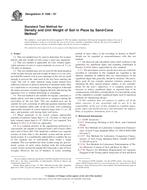Potřebujeme váš souhlas k využití jednotlivých dat, aby se vám mimo jiné mohly ukazovat informace týkající se vašich zájmů. Souhlas udělíte kliknutím na tlačítko „OK“.
ASTM D1556-07
Standard Test Method for Density and Unit Weight of Soil in Place by the Sand-Cone Method
Automaticky přeložený název:
Standardní zkušební metoda pro hustoty a Jednotka tíha zeminy v místě u Sand - Cone Method
NORMA vydána dne 15.9.2007
Informace o normě:
Označení normy: ASTM D1556-07
Poznámka: NEPLATNÁ
Datum vydání normy: 15.9.2007
Kód zboží: NS-17650
Počet stran: 7
Přibližná hmotnost: 21 g (0.05 liber)
Země: Americká technická norma
Kategorie: Technické normy ASTM
Anotace textu normy ASTM D1556-07 :
Keywords:
acceptance tests, compaction tests, degree of compaction, density tests, earthfill, embankments, field control density, field tests, inplace density, inplace dry density, in situ density, relative density, sand cone, soil compaction, soil tests, unit weight, ICS Number Code 93.020 (Earth works. Excavations. Foundation construction. Underground works)
Doplňující informace
| 1. Scope | ||||||||||||||||||||||||||||||
|
1.1 This test method may be used to determine the in-place density and unit weight of soils using a sand cone apparatus. 1.2 This test method is applicable for soils without appreciable amounts of rock or coarse materials in excess of 1 1/2 in. (38 mm) in diameter. 1.3 This test method may also be used for the determination of the in-place density and unit weight of intact or in situ soils, provided the natural void or pore openings in the soil are small enough to prevent the sand used in the test from entering the voids. The soil or other material being tested should have sufficient cohesion or particle attraction to maintain stable sides on a small hole or excavation, and be firm enough to withstand the minor pressures exerted in digging the hole and placing the apparatus over it, without deforming or sloughing. 1.4 This test method is not suitable for organic, saturated, or highly plastic soils that would deform or compress during the excavation of the test hole. This test method may not be suitable for soils consisting of unbound granular materials that will not maintain stable sides in the test hole, soils containing appreciable amounts of coarse material larger than 11/2 in. (38 mm), and granular soils having high void ratios. 1.5 When materials to be tested contain appreciable amounts of particles larger than 11/2 in. (38 mm), or when test hole volumes larger than 0.1 ft3 (2830 cm 3) are required, Test Method D 4914 or D 5030 are applicable. 1.6 It is common practice in the engineering profession to concurrently use pounds to represent both a unit of mass (lbm) and a unit of force (lbf). This implicitly combines two separate systems of units, that is, the absolute system and the gravitational system. It is scientifically undesirable to combine the use of two separate sets of inch-pound units within a single standard. This test method has been written using the gravitational system of units when dealing with the inch-pound system. In this system the pound (lbf) represents a unit of force (weight). However, the use of balances or scales recording pounds of mass (lbm), or the recording of density in lbm/ft 3 should not be regarded as nonconformance with this test method. 1.7 All observed and calculated values shall conform to the guidelines for significant digits and rounding established in Practice D 6026 unless superseded by this standard. 1.7.1 The procedures used to specify how data are collected, recorded or calculated in this standard are regarded as the industry standard. In addition they are representative of the significant digits that generally should be retained. The procedures used do not consider material variation, purpose for obtaining the data, special purpose studies, or any considerations for the users objectives; it is common practice to increase or reduce significant digits or reported data to be commensurate with these considerations. It is beyond the scope of this standard to consider significant digits used in analytical methods for engineering design. 1.8 This standard does not purport to address all of the safety concerns, if any, associated with its use. It is the responsibility of the user of this standard to establish appropriate safety and health practices and determine the applicability of regulatory limitations prior to use. |
||||||||||||||||||||||||||||||
| 2. Referenced Documents | ||||||||||||||||||||||||||||||
|
Doporučujeme:
Aktualizace technických norem
Chcete mít jistotu, že používáte pouze platné technické normy?
Nabízíme Vám řešení, které Vám zajistí měsíční přehled o aktuálnosti norem, které používáte.
Chcete vědět více informací? Podívejte se na tuto stránku.




 Cookies
Cookies
